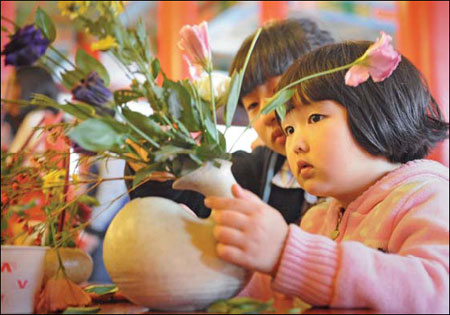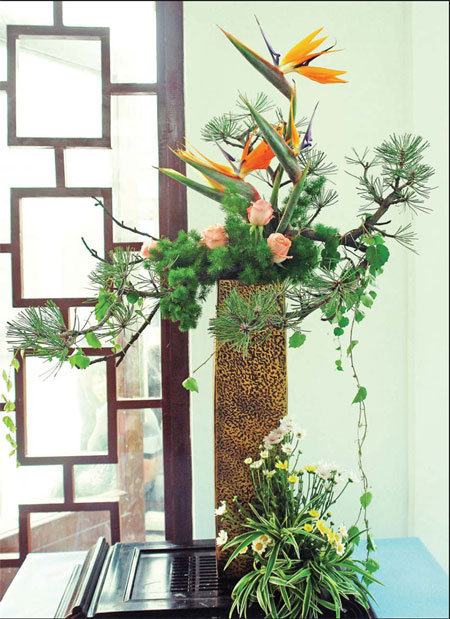Blooming history
Updated: 2013-03-15 09:06
By Zhang Lei (China Daily)
|
|||||||||||
|
Flower arrangement was seen as a standard pursuit for inner tranquility. Provided to China Daily |

Master picks natural approach in reviving lost art of flower arrangement
We all know that flower arrangement is not as easy as it looks.
But while there is a lot more to it than meets the eye, neither is it an academic discipline - except perhaps at Beijing Forestry University.
There, among the programs on soil conservation, landscape gardening and biotechnology, courses are held in the ancient and, at least in China, noble art.
The flower arrangement sessions draw in not only the regular students, but also members of the public, particularly local workers, who are looking for an engaging but relaxing divertissement from their routine.
Adding to the floral attraction is the fact that the tutor, Wang Lianying, is the director of the China Flower Arrangement Association and one of the country's top three masters in the art.
Her work on retracing the lost techniques, recorded mostly in ancient Chinese paintings, has brought her nationwide fame and a group of dedicated followers.
"Ten years ago, such classes as these wouldn't get many enrollments," she says as she examines the work of her students, offering constructive criticism along the way.
Few of the uninitiated would notice the difference in what would appear to be minute changes in the arrangements, although to Wang, they make a world of difference.
"I have thumbed through more than a 100 ancient drawing books to revive this old art," she says.
The Chinese stopped keeping a systematic record of the flower arrangement tradition more than 250 years ago. The art was put on hold due to poverty and war in the mid-to-late Qing Dynasty (1644-1911), and it was not until the 1990s that the Chinese started to realize its importance in their culture, especially when Western and Japanese styles had become the tall poppies in the field.
The Japanese by this time had spiritualized their flower arrangement, incorporating it within a religious framework, whereas Chinese flower arrangement, the prototype of Japanese ikebana, was recognized on a much smaller scale.
"This is one of the motives that drove me to do research and teach such courses in the first place," Wang says. "Chinese flower arrangement, although not being mainstream at present, is not at all inferior to the other two styles."
One of her most popular weekly courses is "Chinese flower arrangement and Japanese hanamichi", held in a corner of the verdant campus, where she lectures on the relationship of the two forms and their evolution. In 2009, her flower arranging technique was included in the national intangible cultural heritage list.
Chinese flower arrangement first appeared during the early Southern and Northern dynasties 1,700 years ago. However, Wang believes it started much earlier.
The Book of Songs written more than 3,000 years ago features many scenes of young lovers cutting flowers, twigs and leafs as tokens of courtship.
In the Late Eastern Han Dynasty (AD 25-220), with the introduction of Buddhism from India, practitioners started to place cut flowers at temple altars, and for a long time, flower arrangement took on a strong religious flavor with strict rules.
Part of the reason was that Buddhism forbids the killing of animals, and so cuttings from plants were used as offerings. Also, dedicating time to arranging flowers and leaves symbolically and aesthetically reflects continuous piety toward the Buddha.
For example, bamboo, peach and pear trees are used to represent longevity. The tiger lily, pomegranate and orchid symbolize fertility, and the peony, regarded as the "king of flowers", stands for wealth and good fortune.
During the Southern and Northern dynasties (AD 420-581), rules were relaxed and an influx of variations followed, including flower arrangement in hair styles and costume decoration, such as brooches. From this period, flower arrangement blossomed into a much more artistic pursuit.
In the Tang Dynasty (AD 618-907), flower arrangement became popular among aristocrats and the imperial court. The emperor Li Yu held an annual flower arrangement exhibition at his palace.
It was also during this period that the art spread to Japan.
Come the Song Dynasty (AD 960-1279), the art gained wider popularity, especially among the literati, and artistic conception became more varied as new cutting techniques were introduced.
Flower arrangement, along with tea making, mounting of paintings and incense burning, was regarded as a standard pursuit for gentlemen who sought inner tranquility.
Plum blossom, orchid, bamboo and chrysanthemum are deemed the four gentlemen of flowers, because the plants' natural characteristics have something in common with human virtues.
In flower arrangement, these flowers are cherished for their representation of loftiness, righteousness, modesty and purity.
During the Ming Dynasty (1368-1644), more weight was placed on naturalism, with less emphasis on the balance of beauty, structure and meaning. It promoted asymmetrical beauty, which also had a great influence on Chinese garden design and landscaping.
Naturalism is Wang's ideal of perfect flower arrangement. Symmetry, with straight columns and lines, would look rigid and unnatural. Wang is strongly against tying flowers up with knots to this end.
But "naturalism does not mean arranging the flowers chaotically or prosaically", she says. "There are still limits. In one composition, two or three varieties are enough, whether the branches are short or long, and the flowers sparse or thick. One should always follow the botanical principles keep the appearance natural."
zhanglei@chinadaily.com.cn
(China Daily 03/15/2013 page26)
Today's Top News
Police continue manhunt for 2nd bombing suspect
H7N9 flu transmission studied
8% growth predicted for Q2
Nuke reactor gets foreign contract
First couple on Time's list of most influential
'Green' awareness levels drop in Beijing
Palace Museum spruces up
Trading channels 'need to broaden'
Hot Topics
Lunar probe , China growth forecasts, Emission rules get tougher, China seen through 'colored lens', International board,
Editor's Picks

|

|

|

|

|

|






